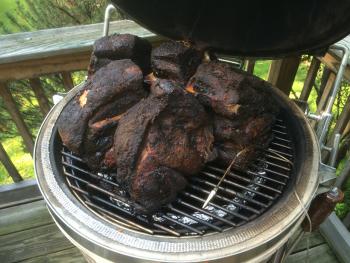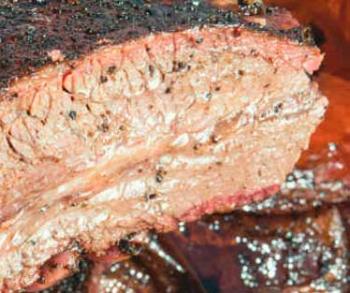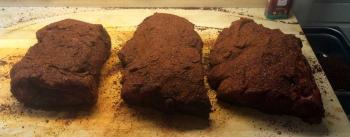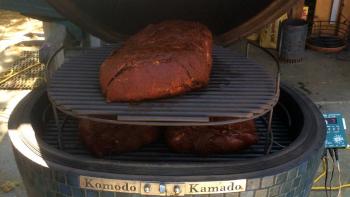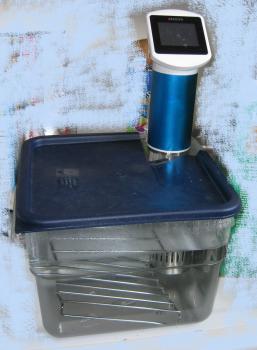-
Posts
1,738 -
Joined
-
Last visited
-
Days Won
53
Content Type
Profiles
Forums
Events
Everything posted by Syzygies
-
I gave away my first over-featured BBQ Guru, and used a Pitminder till it died. It had exactly what I wanted, a manual "rotary phone" oven dial. When it died, it had long been discontinued, and I didn't like anything I saw available, and went two years without. I had some big cooks this summer, so I bought a DigiQ DX2: https://www.bbqguru.com/StoreNav?CategoryId=1&ProductId=22 They've had a bit of trouble with too thick a powder coat on the case, causing the control buttons to push inward under a hot sun, and activate on their own. In my case, it set my target pit temp to zero, which I suppose is better than 450 F. I exchanged it (outstanding technical support) and I've had no further trouble. In principle, one voids the warranty by opening the unit, but it's held together by one easily removed screw; if I had a major cook on the line I'd open it again, sand the holes clean, and ask for warranty service anyways. I'd buy this exact unit again. The WiFi has a definite appeal, but I like simplicity. I like that it fits the guru port on my KK, and I like that it runs on 12V not 5V, matching the needs of the LED lighting over our eating area. It was extremely helpful, stabilizing my friend's off-brand K5 while I was out playing. One doesn't need a controller for a KK. One doesn't need a GPS for a car. The right degree of automation is a personal choice. I had no trouble turning out great barbecue during the two years I was without a controller, and yet I'm very happy to have a controller again.
-
One could even write equations for this, but the intuition is absolutely spot-on. Car dealers say "People buy horsepower, but they drive torque." In outer space, one can spin an arbitrarily massive object with one's pinky finger, but there is an energy transfer that takes lots of patience. For a perfectly balanced rotisserie, the bearing resistance tends to dominate. Unless you trim your meat first on a lathe, it will be impossible to figure out how to attain perfect balance, and the bottleneck will be lifting the imbalanced meat. Watch the meat as it rotates, and fiddle, knowing this is the issue. The best chicken I've ever had from a gas grill was using a rotisserie. I prefer managing chicken by hand on my KK grates, and we gave away our rotisserie to a new KK owner. He didn't want it either, but I never picked it back up and we lost touch. Part of the deal is that the KK grates are so much easier to clean up than a rotisserie. I never tried more massive roasts that might benefit from the rotation.
-
That is my absolutely favorite piece of meat on a pig. I used to sample bits of this by cutting it off a rib rack I had previously seasoned with dry rub, to check for salt, and quickly pan-frying. Fantastic for any purpose, up there with fish cheeks. I wish I could buy these separately in bulk.
-
The K5 is in surprisingly good shape, considering it winters in Ithaca. No cracks, one missing tile. Sacramento vintage, it depended what worker you got, as tile application involved unregulated application of a lot of white adhesive goop. My friend rarely uses it. I pulled out six inches of wet ash, then ran it 12 hours before putting in the butt. I beat my K7 to death before buying a KK. The K7 sees some use in my neighbor's yard, NO tiles. My KK takes the same abuse I gave the K7, and it basically looks brand new. Kudos to Dennis.
-
A bit disorienting cooking on my friend's off-brand K5, but we're making it work. We figure The Piggery http://www.thepiggery.net/pigblog/ sells these quarter round tree trunk butts to save the rest for their sausage work. In any case, "Pork Henge" works for fitting 25 lbs of butt into a small space. Preheating for 12 hours before rebuilding the fire and adding the meat, smoke pot was a useful step.
-
Here, here. I preorder three for my diaspora. After finding six inches of wet ash at the bottom of my friend's off-brand K5, I decided to run it without meat for as long as possible, then reload fuel before my cook. This left the problem of adequate smoke production from my smoke pot, going cold into an already stable fire. Luckily, there was a gas grill right next to the K5, which I used to preheat the smoke pot as hot as possible. Did the trick, nice smoke shortly after rebuilding the K5 fire. I'm also glad I sent an Amazon box of Dennis charcoal in advance of my arrival, and brought out my new BBQ Guru, keeping as much familiar as possible. http://www.thepiggery.net/pigblog/ The Piggery sells carefully raised pork at twice what we've ever paid before. A "Boston Butt" looks like a quarter round of tree trunk with fat for bark, and weighs at most five pounds. Pre-ordering means they save you some, not that they cut differently. Pork shoulder is of course the perfect cut for making sausage, which they sell lots of, so my theory is that this squared off potato of a butt is how their sales ecosystem works. This turned out to be a blessing, more area for rub, more bark, and I could fit five of these in a Democratic firing squad, fat up and out, under my friend's K5 dome. For a 25 lb payload, pretty much the limit of this equipment. [Edit] Yield was less than expected (though plenty). Sawing into quarter rounds (like a tree trunk with fat as bark) is something taking far less skill than, say, a Starbucks barista. I suspect they do have butcher skills, though Ithaca does place more weight on the politically correct ethical treatment of animals than any intelligence in the butchering. Nevertheless, with a band saw they aren't following the structure of the bones. I saw bone fragments I've never seen in any pork butt, or for that matter whole shoulder, in my life. If one posits more butcher skills, they are being selfish in making sure that the scraps they keep are easy to work with for making sausage, because that's work they have to do. Excellent flavor, though.
-
The cleaning pads I like best so far are 3M Heavy Duty Stripping Pads: http://www.amazon.com/Heavy-Duty-Stripping-Pads-No/dp/B001B58CRQ Above is an Amazon link. In practice, they're available with painting supplies in many hardware stores. If you ask for them by exact name, staff might know what you're talking about. I've been reduced to staring at the "prep" section of the painting aisles. These aren't heat-proof, so I generally use them while soaking a grill in a metal water heater pan with the exit hole blocked (improvise; there are many ways to do this; I screwed together some plastic parts). They're coarse and thick, stiff enough to clean nicely between the grates of a KK; they might not fit between the grates of a lesser brand grill. My practice is to do a rough clean in place with the Grill Floss metal tool, then soak and clean more carefully in my wading pool replacement. (Wading pools also work.)
-
I'm making three pork butts, second Sunday in a row. This time, in Ithaca for my niece's wedding, borrowing a friend's K5. That will be an interesting, close fit. I did bring out my BBQ Guru. The good news is the pig source: http://www.thepiggery.net/pigblog/
-
If there's not actually a seal, there will be a bit of convection. Picture blowing compressed air into the bottom holes. Would it come out the top between the lid and the pot? Of course. That said, I could imagine living with faintly more smokiness, sometimes by choice. After reading Aaron Franklin, and feeling bad I don't have the "basic metalworking skills" to cut up a 1,000 gallon propane tank, I started thinking. It wouldn't be too hard to thread holes into the Dutch oven "ears", and screw in stainless steel hex head bolts to secure the lid. Others like a camping stove sold at REI. I found it too thin, and thus too aggressive, but this is a matter of taste. [Edit] Shopping for another Dutch oven to experiment on, I'm between a rock and a hard place. The cheap Dutch ovens with ears to take a threaded hole have (according to reviews) poorly fitting lids. Lodge costs twice as much, and the only way I see to secure the lid would be with a single long bolt through the center of the bottom and the center of the lid. Could work...
-
Quite by accident I discovered that one can buy very coarse, fat cleaning scrubbies in the painting aisle of a hardware or box store. The ones I got are so fat (drum roll... ??) that they squeeze nicely between the grates. For scrubbing a grate in a metal water heater catch pan, these are ideal. I do also love my grill floss. It's bending around on me, may be time to see which size wrench...
-
Galvanized metals produce toxins when heated in a BBQ cooker. I came up with the Dutch oven smoke pot idea a decade ago, on the off-brand K7 I was using then. One can usually get away without flour paste, and it of course depends on the Dutch oven. After a few cooks where I had to rip apart the cook to get at a smoke pot that had lurched over on shifting charcoal and spilled open, I don't risk it. Really not a big deal, make a little ziplock bag and let the flour water paste sit a while, like hydrating bread dough. For me, the paste always thickens and settles into a fairly ideal and easy to use mixture. The tricky part of Dutch ovens are getting them started so the smoke fits your schedule. I tend to start my fires with a propane weed burner. (My other contribution to BBQ is adding a hose clamp to weed burners so they can perch just so on the edge of the KK. I also weigh salt, but I learned that from Paul Bertolli.) These days, I'm happier if I aim the weed burner at several side of the Dutch oven, only incidentally lighting KK extruded coconut lump charcoal under the pot as I completely heat up the pot. This gives me a quality of smoke I like, right away if I'm eager to add my meat.
-
After not buying a BBQ book in over a decade, I thoroughly enjoyed Aaron Franklin's Franklin Barbecue: A Meat-Smoking Manifesto, published in April 2015. http://www.amazon.com/Franklin-Barbecue-Meat-Smoking-Manifesto-Aaron-ebook/dp/B00N6PFBDW/ As everyone's circumstances are different, and our ceramic cookers behave very differently from Webers or offset-fireboxes, the only book I'd found useful back in the day was Robb Walsh's Legends of Texas Barbecue Cookbook, which by describing the history and diversity of techniques in central Texas BBQ, serves more as background philosophy for one's own search than an actual cookbook. http://www.amazon.com/Legends-Texas-Barbecue-Cookbook-Recollections/dp/0811829618/ Aaron Franklin is self-taught, while very much in the central Texas tradition. There's a remarkable similarity with self-taught bread bakers, who have written the most useful tomes in that category. The obligatory restaurant origin-legend is nevertheless an amusing read. Then an equipment chapter that dives headlong into how to make the ideal smoker from a 1,000 gallon propane tank, assuming basic metal-working skills? Ha, reading this is as close as I may come to welding. Franklin's preferred style involves a very contemplative, simple treatment of the best meat available. This was the hook that got me in: I felt like everything I'd learned in a decade was an itty bit of what he had figured out with a compatible philosophy, and that by the end of a day's reading I'd be transported much further along. Then the differences became apparent. His preferred pit temperature is 275 F for everything. Rub goes on by eye (no weighing salt) mere hours before cooking. He manages moisture along with smoke, and foils (or butcher paper for brisket) to close out the cook. Again like running a bakery, there are many schedules that could work, but one needs to figure out a protocol that maximizes production given the logistical contraints of available storage, equipment, and worker schedules. His discovered principles are as much a solution to these constraints as global truths. Our problems are different; my biggest logistical concern is fitting the cook around a night's sleep. Nevertheless I intend to try his protocols as close to verbatim as one can in a ceramic cooker. Once one has hit a plateau in anything, one can only go further by starting again from scratch, and seeing if the "science" one believes is repeatable. If I fear anything from old age, it is the "I already know I am right!" ossification that keeps one from venturing back down these rabbit holes. While I can "place" this book as cooking the highest quality meats in a central Texas tradition, its greatest strength is explaining a system of thought that allows one to adapt to changing circumstances. Mainstream books assume a Weber and cheap meats, teaching how to mask all this with 12 ingredient sauces. Franklin is unapologetic about the chapter on welding, but has dealt with his fair share of hardships trying to produce great BBQ while traveling. There's been much debate in this forum on the best way to cook brisket; Franklin sees a continuum of technique parametrized by the characteristics of the meat, melding the fast and slow approaches debated here into one world view. I nervously read into the section on "dwells" wondering if he'd flub the science, only to realize that he understood dwells better than any author I'd read. He then takes some of the myth out of smoke rings. I'd had the impression that BBQ judges get their tastebuds zonked early from bad smoke, and go by visuals that competitors learn to manipulate. Just as the crema in a good espresso is an easily manipulated artifact orthogonal to actual coffee quality. Franklin doesn't worry about producing smoke rings. The recipes are if anything an afterthought, one learns instead from all these master class side discussions. The recipes serve to consolidate the points in the book, to make it clear there really isn't anything else going on. It was fun reading this after serving pork butt to 60 people for Sunday lunch, and deflecting every "what did you do?" question with "as little as possible". The discussions on trimming and on slicing brisket are alone worth the price of admission. This is a "once every decade" BBQ book for me, highly recommended.
-
The digits flicker, we can't see it but the camera won't see all digits at once. A "twitter" version of car wheels rolling backwards in old movies.
-
By chance I'm cooking triple butts two weekends in a row. Not sure what's up with "7" on the guru. My camera is acting up. It won't take my picture in a mirror either, it's like I'm not even in the room!
-
I understand that there are plenty of opportunities for 48h sous vide. Usually cuts that we'd cook overnight in a KK, or braise all day in a clay pot. For steak, I choose somewhere between minimum time till temperature stabilizes (usually an hour) and some additional time to tenderize more challenging but flavorful cuts (usually several hours). While I don't sweat it if dinner turns out an hour late, I've never applied 48h sous vide to steak. Except for brisket and pork butts, which welcome several days of advance planning, I rarely have any idea what I want to eat two days from now! My advice for anyone starting out, with a steak they would have simply grilled in an earlier era, is to sous vide 1 to 2 hours. The interesting question is the target temperature, a matter of family personal preference. My family prefers 134 F or 136 F, which I've learned to enjoy, migrating from my very rare "just pull the shards of windshield out!" inclinations.
-
I helped a friend release his stuck #5 POSK damper. Think "strap wrench" and design a tool two people can operate, involving a stick and straps. Working without an improvised tool is a shoulder injury waiting to happen. The damper assembly can simply fail rather than twist free. We also used some scary solvent like WD40, which we were careful to burn off. When I had my #7 POSK (before my 23KK), I found a stainless steel nut and bolt matching the damper threads. I'd regularly disassemble the damper, then have a swingers partner-swapping party with these four parts and some food-grade grease. Cleans out the built-up gunk and corrosion. Notice that there are threads that can't be cleaned by use alone, because they're past where the damper is completely shut. A lot of crud builds up past this point; a separate nut can clean past this point. With this maintenance procedure, there should be no further problems. Although, one gets these problems by not using the POSK. If one isn't using it, one isn't carrying out maintenance either. Give it to someone who'll use it (like I did) and buy a KK.
-
I used a batch of fig wood about a decade ago, for spareribs and such. Apparently the "farmer" who delivered it to Monterey Market in Berkeley pulled up in a car somewhat north of $100K. I found it delicious but a bit "distinctive". This is a spice, and one wants the primary impression to be the stellar hunk of protein itself, not the spicing. So this calls for moderation. It's easy to get enamored with new toys, but in cooking, if your guests even notice the odd ingredient, you've lost. Instead, they should simply be wondering why the food tastes so good. Were I using it again, I'd blend it with the vanilla ice cream of the smoking woods world: Apple. In a smoke pot.
-
http://www.amazon.com/gp/product/B0001MRUKA/ http://www.amazon.com/Cambro-SFC12453-Polyethylene-Covers-Blue/dp/B001E0HRVK/ A 12 quart polycarbonate Cambro makes a nice water bath. Polycarbonate can take the heat, and insulates much better than a metal pot. Cut a corner out of the lid, to reduce evaporation. We've moved ours to on top of the dryer. Keeps heat and noise out of the kitchen. This rig is also awesome for defrosting vacuum-packed food. Just set the target temperature to 0 C. The heater will never turn on, but the circulating pump will speed the defrost along. (The metal grid is left over from a Sous Vide Supreme that we donated to Good Will. We were clearly never going to use it again, but I saved some hardware.)
-
(Maillard reaction) I have several Anova Ones; they're better than any system I've used before. No one gets excited about basic cooking steps like incrementally better vegetables, but sous vide excels here. I'm having a Moroccan beet salad as I read this, for breakfast. Peel and cube beets, sous vide 75 minutes at 85 C, chill in the bag, then prepare as you like. Same with potatoes, later pan-fry in ghee over searing heat. 85 C is the threshold at which vegetables cook, and this method locks in flavor without introducing additional moisture (alas, also without removing any moisture). Thomas Keller prefers to flash-cook green vegetables in a giant pot of boiling salt water, then flash-chill in ice water, to preserve the color. I like the drab color of Italian well-cooked vegetables, and I'm not running a restaurant, so I'll even sous vide green vegetables at 85 C. I do also love Keller's big pot approach. For a related step at a lower temperature, http://sweets.seriouseats.com/2011/10/the-food-labs-apple-pie-part-2-how-to-make-perfect-apple-pie-filling.html Sous vide apple pie filling is an interesting idea. The basic idea of an apple pie is fraught with peril, but people get it to work pretty well, accepting the limitations of the method the way we accept so many quirks of life. And a basic homemade apple pie is pretty far up the food chain from simply buying one at the supermarket; I commend anyone who goes this far. Nevertheless, the simplest fix here is to confront the reality that having raw apples tag along for the ride is the source of all troubles with apple pie. A sous vide filling is one solution; we found ourselves just wanting to eat the filling, skip making the pie. We're also partial to French galette, where one cooks the filling first in a skillet. That has the advantage of abusing and reducing the apples a bit. Maillard reaction, yada yada, the "epoxy B" to building flavor when sous vide is a step. In a nutshell, this is the crux issue with sous-vide. It is simply a step, that cooks an ingredient with minimal fuss. If the ingredient is fantastic, the result will be fantastic. If the ingredient is drab, the result will be drab. Nowhere to hide here.
-
Wow. What fun to find this thread. I dug up this photo from 2005 (before my KK) to illustrate the idea Dennis had of directing smoke pot gases underneath the charcoal. If the fire gets a bit hot, these gases will take off on their own. In fact, I stumbled onto the smoke pot idea rather by accident. I was experimenting in 2005 with making charcoal: A basic technique is to heat a sealed wood chamber over a fire, with only a few holes at the bottom facing the fire. There's a threshold where the gases from the chamber take over, and one no longer needs the fire. Because oxygen doesn't enter the chamber, there's some material left when the process finishes, which one harvests as charcoal. After making a few batches of charcoal inside my ceramic cooker, it dawned on me that I could scale this down as a smoke source for cooking. The idea was like fractional distillation; I didn't want any of the nasties from actual combustion of the wood. (This is rather like "vaping".) After reading about Danny Meyer sinking a small fortune into custom barbecue equipment in a New York City restaurant, I wondered why one couldn't build a chamber to produce wood "gas" to pipe into a separate gas oven. Why not cook with all the usual controls of a fancy gas oven, and with the flavor of wood? I can see some engineering challenges here, but this could work. I do seal my lid each time, with a flour water paste squeezed out of a plastic bag with the corner nicked. Some lids will seal on their own better than others, but a paste seal will always have some effect, preventing any convection through the pot. I like how this tames the smoke, it becomes one more seasoning in balance. I've long realized that the flour paste step interferes with adoption, and it may not be critical, but it's far from the hardest thing I do in the kitchen. One gets used to anything, and it helps in the kitchen to fear nothing. Yes, I use a new drill bit and a bit of oil to drill three 1/8" holes in the cast iron. A cheap bit will do; it is sacrificial. In case anyone is motivated to make further experiments, here are some successes and failures from the past (various people): One can buy stainless steel camping cook pots where the lid clamps on tight. These pots haven't worked as well for me. One can also special order (for a small fortune) stainless steel pipes with threaded caps (think pipe bomb) for a better seal without flour paste. I haven't; the flour paste really doesn't bother me. Why stainless steel in each case? Various metals off-gas toxins when heated; one should be truly paranoid about using compound metals one doesn't understand around food. Have you ever seen galvanized metal for a cooking vessel? There's a reason you don't want to be the pioneer here, either learn the reason or be cautious. Not every smoking wood comes from a tree that produces food, but that's a safe start if one doesn't know. One doesn't need to stick to cast iron or stainless steel, but that's also a safe start if one doesn't know.
- 51 replies
-
Lucky me, my first ceramic cooker was my idea, but the KK was Laurie's idea. I swear she bought it for the chance to talk on the phone with Dennis. He really is that charming. Guys: Arrange an incoming call, and have her pick up...
-
Yes. Our oven broke just after our first ceramic cooker. I still remember that strawberry rhubarb pie. Our most frequent KK use, again tonight, was bread. Never waste a fire, we put in our usual Spanish cazuela filled with potatoes, onions and spices. I was a little heavy-handed tonight with the pimenton, and boy do the potatoes smell good.
-
You do have neighbors? It's amazing how accepting people are of the sort of obsession you describe. There are many a tale on the web of extended power outages after natural calamities (as simple as an ice storm, or for example a hurricane) where a ceramic cooker runs 24/7 preserving the food from everyone's thawing chest freezers. Lesson: Keep plenty of charcoal on hand for the zombie apocalypse!
-

Best vacuum packer? (FoodSaver alternatives?)
Syzygies replied to Syzygies's topic in Relevant Product Reviews
I never liked the form factor of the VP112 but jumped on the VP115. It is smaller than a VP215. If one can manage the space and weight, the VP215 oil pump is an advantage: Greater vacuums, and if water gets into the pump just change the oil. I have two of the original Anova One circulators ($170 on Amazon) that go in 12 quart Cambros. I get the cooler idea, but Cambros (unlike metal pots) provide enough insulation (remarkably) that one can move on to life's other pressing questions. Cambros are easy. Cut the lid to make room for the circulator. One circulator is for vegetables at 85C, the other is for anything else I want to cook at the same time. -
Mine is manual, won't do this. I love McCann steel cut Irish oats. My Irish ancestors described a very slow process for cooking these oats. I have one of the better Zojirushi rice cookers on each coast. While we most often use it for organic brown rice from http://massaorganics.com/, there's a porridge setting and a timer. In my opinion, this is the way to go, to wake up to Irish oats. (Hey, at least I'm consistent.)



